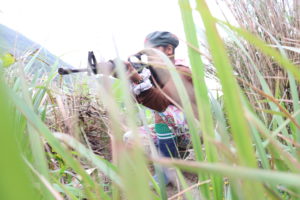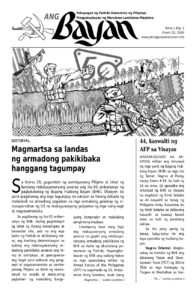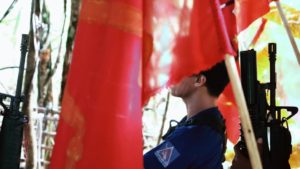NPA-NCMR’s diverse and advanced medical work experiences

This article is a contribution of the New People’s Army-North Central Mindanao Region (NPA-NCMR) to the Ang Bayan series showcasing advanced and contemporary experiences of the NPA in various fields of work. This is part of recognizing the accomplishments and victories of the NPA in the past 50 years. Ang Bayan is calling on NPA operations commands at all levels to contribute their experiences as part of the preparation for the 50th anniversary of the NPA this March 29.
Health work is part of waging the revolution,” said Ka Iris, a member of the Regional Medical Staff of the New People’s Army (NPA) in the North Central Mindanao Region (NCMR), in an interview last December 2018.
As an independent people’s army, this is a crucial NPA line of work. It covers healthcare for Red fighters, sanitation, first aid, and even carrying out major and minor medical operations. Major medical operations include combat surgeries or operating on injuries sustained during armed encounters.
Medical committees and groups are established in every front and company wherein its members’ skills are forged through theoretical and practical trainings. These include basic, intermediate and advanced health courses.
Medical officers in NCMR are now a size of a company. Conferences and trainings have been conducted to enhance their skills and has resulted in more efficient provision of basic health services to the people’s army and the masses.
Major and combat operations
One of the specialties of medical committees in the region is on treating gunshot wounds (GSW) sustained by Red fighters during armed encouters.
Among the medical breakthroughs of the regional medical committee was a successful operation on a Red fighter who was shot on the chest last May. In a guerilla zone, a team performed thoracostomy to stop the bleeding inside the pleural cavity where the bullet was lodged. This condition is called tension pneumothorax with hemothorax, wherein the presence of blood and water in the cavity constrict the lungs. During the operation, the patient’s chest was punctured and inserted a chest tube to drain the blood and water.
The medics closely monitored the patient on their way to the first medical station. They alternately carried the patient towards the second station where the operation was conducted. “We operated on the patient in a hammock because it was too painful for him to lie down,” narrated Ka Mitch, one of the unit’s medics. “Four medics worked together in the operation.”
“We were nervous because we’ve never performed such procedure,” Ka Mitch added. “It was challenging.” Some processes were not followed due to lack of equipment. “The tubes we had were too short and had to be attached.”
“We referred to several documents and consulted those who have performed the procedure.” The actual operation lasted an hour. The patient was saved and was able to return as a regular Red fighter after three months.
Another recent expereience was the performance of an emergency redact procedure to a farmer who accidentally chopped his foot with an axe. His metacarpals suffered trauma and the tendons were severed.
After providing first aid to the patient, the NPA medical staff organized their operating room. They administered general anesthesia to the patient while mending his broken bones and stitching the tendons. Using the basic surgical instruments, the medics gave their all to save the farmer’s foot.
“Four medical teams worked in the operating room,” shared Ka Amy, one of the medics who attended to the patient. There were a team of surgeons, a team who performed the anesthesia, a team of “scrubs” or assistant nurses, and a “ciruclating team” responsible for preparing the instruments and other needs.
“There was a time when the patient’s vital signs became unstable. This was a problem as this could lead to cardiac arrest.” The anesthesiologists were alarmed when the patient’s pulse rate reached 100, but were able to eventually take control of the situation.
Among the anesthesiologists’ tasks is to monitor the patient’s vital signs and the effect of medicines on the patient. Due to the lack of medical equipment, they had to verbally update the surgeons on the patient’s vital signs such as blood pressure every ten minutes. “On other operations, we use board and paper to record and draw the pattern of the patient’s vital signs,” Ka Amy narrated. “But in this case, the anesthesiologist verbally relayed them.”
The operation lasted for two hours. It took time because of the thorough process of mending the patient’s tendons and skin.
The medical staff closely monitored the vital signs of the patient in the next 24 hours. They cleaned his wounds in regular intervals, ensured he took the right medicine on time and monitored his urination and bowel movement.
For a week, they took care of the patient round the clock. The patient was well towards full recovery a few days after the operation. The medical staff left a detailed instruction to the patient and his caregivers to ensure that he recovers on time and properly.
The patient and his family were grateful since having the operation in a public or private hospital outside the guerilla zone meant spending thousands of pesos for the procedure alone.
Mass clinic
Aside from these activities, the committee also active conducts medical work in communities and barrios. The NPA mounts regular mass clinics to provide free dental and medical consultations and medicines to the people.
In 2018, around 5,000 patients benefitted from NPA health services such as check-ups, circumcision, dental services such as tooth extraction and providing dentures, cyst operations and others.
It also organized Barrio Medical Groups in various fronts. These groups partner with the people’s army in providing community health services.
The committee also developed and conducted trainings on the use of medicinal herbs (especially for cough and skin diseases) which can be found in the forests.
The medics also perform acupuncture. They had a case wherein a paralyzed patient was able to walk again after undergoing regular acupuncture sessions.
Eye check-ups are also conducted in the region. The committee coordinates with comrades in urban centers to order eyeglasses for the patients. Medics are also capable of making dentures.
On top of these, NPA medics also provide medical services to enemy troopers who get wounded during tactical offensives. Injured soldiers are given first aid.
The health condition of prisoners of war are also well attended to. Medics also conduct daily check-ups and provide the prisoners their maintenance medicines such as those for hypertension and diabetes, among others.
Unity within the committee is key to medical work, Ka Iris shared. “Tasks are efficiently completed when these are done collectively by comrades in the medical team,” she added. “The medics continually learn under the conditions of the intensifying and continuing war,” she concluded.



